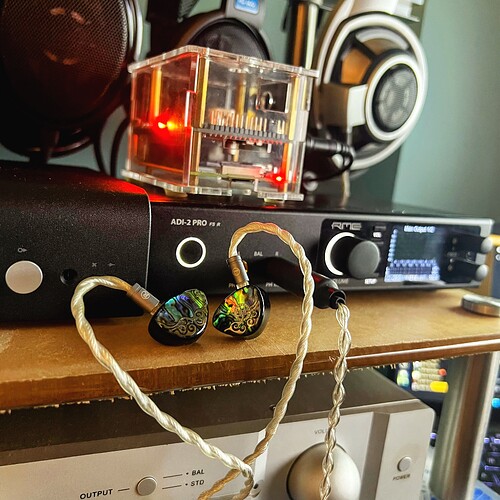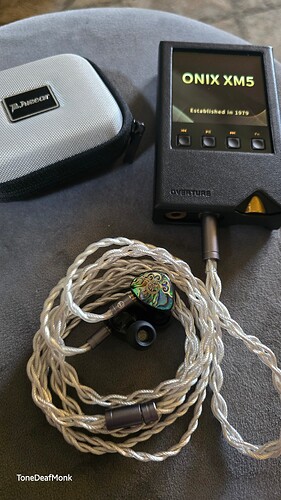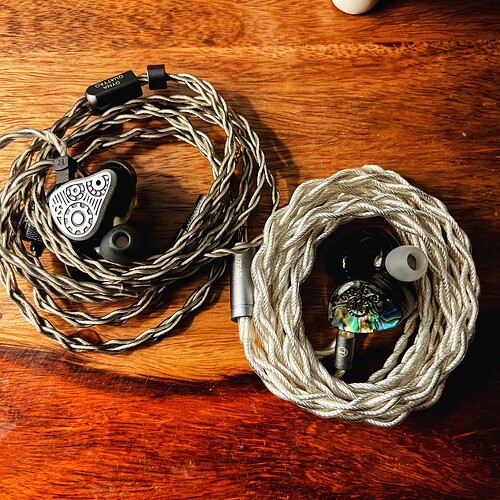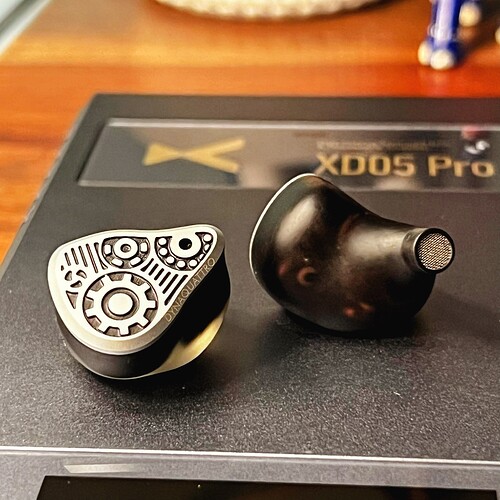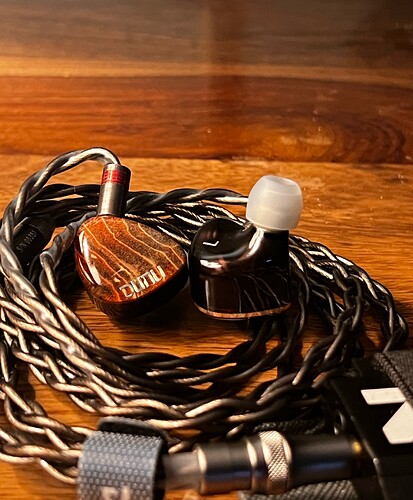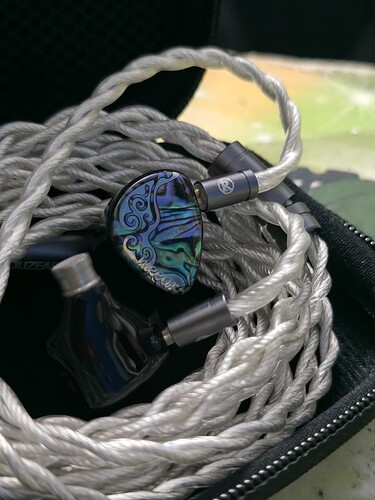Am i wrong, but didn’t somebody else also fairly recently mention this same issue with the 61T?
Some of us did mention this.
Anyone here who tried 61T : what’s your opinion about it’s scalability?
I connected them to my desktop chain and had a few observations but I wanted to validate my observations first before sharing.
Let us know, my unit is on the way
I will keep you posted
I was just discussing this on Head-Fi and here’s what I said:
with moderately powered sources, it’s very strong.
I did however notice that on my desktop stack, the bass is much more dynamic, punchy and well controlled. There was very little effect on mid range and treble though.
Also, here’s the comparison: cross posting this on both Binary thread and here to save time and effort.
DynaQuattro vs Juzear 61T:
At the price point of the Juzear 61T, the treble is tuned more balanced and has a slightly more coherent treble extension with better details. In comparison, the DynaQuattro’s bass is greater in quantity and also tight and controlled, providing the sound with more punch and energy overall. If you’re looking for an IEM that sounds warm, natural, and offers great weight at the low end, the DynaQuattro is for you. For those seeking a more neutral sound signature, with their treble having more finesse and sophistication, the 61T might have the upper hand.
Bass: The DynaQuattro excels in the bass department, with its quantity and tight control delivering more punch and energy. It offers a deep, impactful bass with excellent slam and texture. This makes it highly enjoyable for genres that benefit from a strong low end. The 61T, on the other hand, provides a more balanced bass response. While it doesn’t deliver the same visceral impact as the DynaQuattro, it integrates well with the rest of the frequency range, maintaining a more neutral presentation.
Mid-Range: In the mid-range, the DynaQuattro has a more not too recessed and not too forward presentation and its detailed. Vocals and instruments are more prominent and clear, making it ideal for listeners who enjoy a mid-range-centric sound. The 61Tpresents a slightly warmer mid-range, with male vocals and instruments sounding fuller and richer. This warmth adds a pleasant tonality but might not have the same level of clarity and separation as the DynaQuattro.
Treble: The treble on the 61T is refined and sophisticated, with good extension and detail retrieval. It provides a smooth, coherent treble experience that enhances the overall neutrality of the IEM. The DynaQuattro’s treble, while also detailed and clear, lacks a bit of the airiness that the 61T provides. However, it still offers a high level of clarity and avoids sibilance, making it very pleasant for extended listening sessions.
Detail Retrieval: Both IEMs excel in detail retrieval, but they do so in different ways. The DynaQuattro’s almost perfect mid-range and impactful bass bring out micro-details in vocals and instruments that might be more subtle on the 61T. The 61T, with its balanced tuning and refined treble, captures the nuances in the upper frequencies better, making it excellent for intricate, high-frequency details.
Soundstage and Imaging: In terms of soundstage, the DynaQuattro offers a more immersive experience with a larger, more enveloping stage. Its imaging is precise, allowing for clear placement of instruments and vocals within the soundscape. The 61T has a more intimate soundstage, providing a closer, more personal listening experience. Its imaging is also accurate but might not feel as expansive as the DynaQuattro.
I am still enjoying this set quite a lot. I have listened to a lot of sets, much more expensive than the 61T, at just over $200, and the rule of diminishing returns hits very hard.
You can spend a lot more for a lot less the 61T is not a perfect set , haven’t heard one yet I am still reaching for that mythical set that is just outside my grasp, as this hobby goes and the very deep rabbit hole as we go deeper down.
I hope everyone is getting some love out of their sets as well!
Enjoy the music and the journey.
Keeping it real, Keeping it FUN
TDM
I believe we’re all on the quest for that elusive, all-in-one perfect IEM, but unfortunately, it doesn’t exist IMO, even among high-end IEMs.
Thanks for sharing, that was a fun read. I didn’t expect the takeaway where he says it’s his go-to warm and bassy IEM for around $200. It seems like this IEM is one of those that you either really love or don’t, depending on your personal preference and music taste. But that’s what makes this hobby so great, the variety.
I actually have the Yume Midnight x Crinacle he mentioned in the review. I got it a long time ago because I’m a fan of Crinacle (still am). Back then, there weren’t many collaborations, and the tuning of many IEMs was hit or miss. Now, we have so many excellent choices.
Anyway, I wanted to say that I didn’t use the Midnight much because its technicalities were average, and it sounded a bit sharp for my taste, which didn’t pair well with my music. This is the biggest difference between the 61T and Midnight to me. It’s rare to find an IEM that sounds sharp nowadays. Ah, we live in good times.
You should listen to Celest relentless ![]()
Not sure if this has been discussed yet but how do these compare to the davinci?
I compared it with the Davinci and Dynaquattro in my review here:
Here was another recient comparison i saw.
61T vs DaVinci vs DynaQuattro:
Sub Bass
61T : The sub-bass is robust and provides a solid foundation, with ample energy that doesn’t overshadow the rest of the mix. It offers good extension and dynamics, making it suitable for genres that benefit from a strong low-end presence.
DaVinci: The DaVinci also delivers significant sub-bass, but it tends to have a more pronounced thud rather than a deep rumble. This characteristic can sometimes dominate the overall sound profile, especially in bass-heavy tracks.
DynaQuattro: The DynaQuattro offers an exceptionally deep and textured sub-bass, characterized by a rich, meaty presence. It strikes a balance between providing impactful bass without overwhelming the other frequencies, making it ideal for a variety of genres.
Order of my pick for Sub Bass:
DynaQuattro > 61T > DaVinci
Mid Bass
61T : The mid-bass is impactful and adds weight to kick drums and other percussive elements. However, it can sometimes bleed into the lower mid-range, slightly veiling details.
DaVinci: The mid-bass on the DaVinci is tighter and more controlled, providing a punchy experience without significant smearing. It manages to keep the bass presence strong without overwhelming the mid-range.
DynaQuattro: The DynaQuattro’s mid-bass is well-controlled and delivers excellent slam and impact. Its dynamic drivers ensure that the mid-bass remains tight and detailed, avoiding any unwanted bleed into the lower mid-range.
Order of my pick for Mid Bass:
DynaQuattro > DaVinci > 61T
Lower Mid Range
61T : The lower mid-range benefits from the added warmth of the mid-bass, providing a rich and full-bodied sound. However, the slight bass bleed can affect detail retrieval in this region.
DaVinci: The DaVinci’s lower mid-range is cleaner and more neutral. It avoids the bass bleed issue, resulting in clearer and more detailed mid-range performance.
DynaQuattro: The DynaQuattro offers a flat and natural lower mid-range, ensuring that male vocals and instruments sound realistic and well-defined. The transition from bass to mid-range is smooth, maintaining clarity and detail.
Order of my pick for Lower Mid Range:
DynaQuattro > DaVinci > 61T
Upper Mid Range
61T : The upper mid-range is well-tuned to ensure vocals have enough energy without becoming shouty. This contributes to a pleasant and engaging vocal presentation.
DaVinci: The DaVinci excels in the upper mid-range, offering a beautifully natural and refined sound. Vocals and instruments in this range are rendered with exceptional clarity and realism.
DynaQuattro: The DynaQuattro shines in the upper mid-range, offering a forward and detailed presentation. Vocals and instruments are highlighted without sounding shouty, making it ideal for vocal-centric genres.
Order of my pick for Upper Mid Range:
DaVinci > DynaQuattro > 61T
Lower Treble
61T : The lower treble is energetic but controlled, ensuring that higher-pitched instruments and cymbals have a good presence without becoming overly bright or fatiguing.
Dunu DaVinci: The lower treble on the DaVinci can come across as slightly dry and scratchy, though this can be mitigated with tip rolling. It maintains a good balance but isn’t as smooth as some might prefer.
DynaQuattro : The lower treble on the DynaQuattro is detailed and clear, offering a good balance between energy and smoothness. It avoids harshness and sibilance, providing a pleasant listening experience for higher-pitched instruments and cymbals.
Order of my pick for Lower Treble:
61T > DynaQuattro > DaVinci
Upper Treble
61T : The upper treble extends well, providing air and shimmer to the sound. It reveals fine details and contributes to a sense of openness.
DaVinci: The upper treble is somewhat relaxed but still provides good detail. It avoids harshness, but the overall treble timbre might not be as refined as 61T.
DynaQuattro: The DynaQuattro offers a balanced upper treble which is detailed enough to provide clarity without any hints of sibilance or harshness. It does however sometimes leave you wanting some sparkle and air.
Order of my pick for Upper Treble:
61T > DynaQuattro > DaVinci
Timbre
61T : Timbre is generally natural, though there are slight compromises due to the bass bleed into the mid-range. Instruments and vocals sound realistic, but not as transparent as DaVinci.
DaVinci: The DaVinci offers a more natural and cohesive timbre, with instruments and vocals sounding lifelike. Its balanced armature drivers contribute to a more refined and accurate representation.
DynaQuattro: The DynaQuattro excels in timbre, offering a highly natural and realistic sound. The use of dynamic drivers ensures that instruments and vocals sound authentic and lifelike, making it a standout in this category.
Order of my pick for Timbre:
DynaQuattro > DaVinci > 61T
Staging
61T : The soundstage is wide and provides a good sense of space, making it feel expansive. Instrument placement is mostly accurate, giving a solid sense of where each sound is coming from, though it may not be as immersive as DynaQuattro.
DaVinci: The DaVinci’s soundstage, while slightly more intimate, does well in imaging and separation. It provides a three-dimensional feel, allowing listeners to pinpoint the exact location of instruments and vocals within the sound field. This creates a more immersive listening experience.
DynaQuattro: The DynaQuattro offers a wide and expansive soundstage with excellent depth. It provides a spacious listening experience, with precise imaging and separation that allows for an immersive and engaging sound.
Order of my pick for Staging:
DynaQuattro > 61T > DaVinci
Instrument Separation and Layering
61T : Instrument separation is very good, especially for its price point. The multiple drivers help in achieving clear delineation between different sounds, though the slight bass bleed can occasionally muddy the lower mids.
DaVinci: The DaVinci excels in instrument separation and layering. Each instrument is clearly defined, and the layering provides a sense of depth that enhances the overall listening experience.
DynaQuattro: The DynaQuattro offers exceptional instrument separation and layering, with each sound distinctly placed within the soundstage. The use of four dynamic drivers ensures that complex tracks are handled with ease, providing clarity and depth.
Order of my pick for Separation and Layering:
DynaQuattro > 61T > DaVinci
Detail Retrieval
61T : Detail retrieval is strong, particularly in the treble and upper mid-range. However, the bass bleed into the lower mid-range can obscure some finer details, making it less transparent compared to higher-end models.
DaVinci: The DaVinci offers exceptional clarity in the mid range however falls short in the micro details compared to DynaQuattro and 61T due to the extremely tamed treble.
DynaQuattro: The DynaQuattro does really well in detail retrieval, offering a good level of clarity and precision across all frequencies. Its ability to capture micro-details and nuances makes it a top performer across all genres of music despite it not having the best extension like 61T.
Order of my pick for Detail Retrieval:
Subjective : DynaQuattro > 61T > DaVinci
Objective : 61T > DynaQuattro > DaVinci
Conclusion
All three IEMs—Juzear 61T, Dunu DaVinci, and Binary Acoustic DynaQuattro have few similarities but cater to different listening preferences and price points.
Juzear 61T: Priced around $220, it offers a robust and dynamic sound with a U-shaped signature emphasizing sub-bass and treble. While it excels in providing a wide soundstage and good instrument separation, it does have some issues with bass bleed affecting mid-range detail. It’s a strong contender in the sub-$300 category, particularly for those who enjoy a bass-forward sound.
Dunu DaVinci: At $300, the DaVinci delivers a more refined and balanced sound with a lot of focus on Sub-bass. It does well in imaging, instrument separation, and detail retrieval, though its bass dominance can sometimes crowd out the details. The treble timbre might require some tip rolling to optimize, but overall, it offers a decent level of technical performance. This IEM is ideal for those who prioritize a natural and cohesive sound with excellent clarity and realism.
Binary Acoustic DynaQuattro: The DynaQuattro, priced around $260, stands out with its use of four dynamic drivers, offering a rich, meaty bass, natural timbre, and expansive soundstage. It provides excellent detail retrieval and instrument separation, making it suitable for a wide range of music genres. This IEM is perfect for listeners who prefer a balanced yet engaging sound with a forward mid-range and detailed treble.
Hahaha, that’s right. ![]()
This IEM and dynaquattro compliments each other TBH. I recommend them both as a complete package.
The vocals are really good in 61T where the low-end is amazing in Dyna
I’m slightly inclined to pick DynaQuattro over 61T. While DQ lacks a bit of emotion in the mid range which 61T has but I found the lower mid range on 61T was impacted by the mid bass.
idk man the 61t just looks beautiful to my eyes haha. My ears are also quite happy with what we have. Sorry for the bad image I just clicked this right before listening a few minutes ago.
I’m so much curious to try the butterflies
Yes and I like that Impact. Neutral lower-mids are not my jam, I need some sense of exaggeration so that majority of my Songs becomes extra glittery/fluid/lush.
